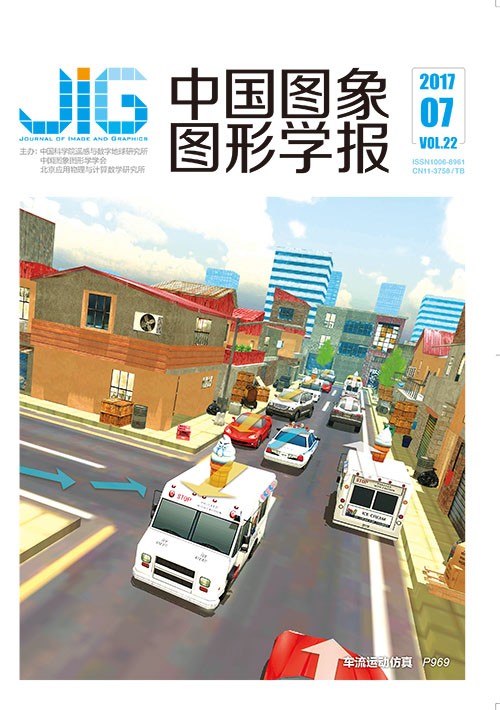
结合天空检测与纹理平滑的图像去雾
摘 要
目的 针对已有图像去雾方法中存在的天空灰暗以及透射率分布与实际情况不一致导致的对比度增强不足等问题,以暗通道先验图像去雾方法为基础,提出结合天空检测与纹理滤波的图像去雾算法。方法 首先,设计了一个基于天空检测的大气光自适应估计策略,以天空区域亮度值较低的像素为依据估计大气光值,能够避免天空色彩失真,获得更明亮且干净的天空恢复结果;其次,对输入图像进行纹理平滑预处理以保持同一平面物体内的像素颜色一致性,并提出一个基于块偏移与导向滤波的透射率精确化计算策略,使透射率估值更符合深度信息的变化趋势,以提升无雾图像的对比度与色彩饱和度;最后,对复原结果进行联合双边滤波后处理,以降低噪声的影响。结果 本文算法得到的大气光估值更为合理,对于不符合暗通道先验的天空区域,能够取得更为自然的天空复原结果;本文算法得到的透射率的变化趋势与实际场景深度之间具有更高的一致性,对于符合暗通道先验的非天空区域,能够取得高对比度与高色彩饱和度的恢复结果。结论 本文算法在大气光与透射率的估值的准确性以及无雾图像的对比度与清晰度增强方面都得到了有效提升,具有较高的鲁棒性,适用于视频监控、交通监管和目标识别等户外获取图像的诸多应用领域。
关键词
Integrating sky detection with texture smoothing for image defogging
Shen Yiyun, Shao Yaqi, Liu Chunxiao, Zhou Huajian, Zhao Jinwei(School of Computer and Information Engineering, Zhejiang Gongshang University, Hangzhou 310018, China) Abstract
Objective Fog results in degradation of contrast and color saturation in the images shot outdoor. Therefore, the visibility of objects will decline, and details will be difficult to recognize. Thus, robust defogging techniques are valuable in the industrial fields driven by outdoor images or videos. Currently, the mainstream defogging methods are based on the foggy image degradation model, and two main problems that come from the estimation of atmospheric lights and transmissions remain. First, sky regions do not comply with the dark channel prior. The atmospheric light, which suffers from the interference of sunlight in the images with large sky area, is overestimated, resulting in gloomy sky regions in the fog-free images. Second, halo effects require being eliminated through a necessary transmission refinement process. However, the existing refinement methods will result in unreasonable transmissions with texture-like fluctuations inside the same planar objects, causing the inconsistency of variation trends between the transmission map and the depth information. Furthermore, these transmission fluctuations exert a negative influence on the contrast enhancement in the non-sky regions, which conform to the dark channel prior. To address the abovementioned problems, we combine sky detection with texture smoothing and propose a new image defogging algorithm. Method First, we design an adaptive atmospheric light estimation strategy based on sky detection, which can avoid gloomy restoration results of the sky regions, to address the overestimation of atmospheric lights in the images with sky regions. Initially, the foggy images are classified according to whether these images encompass sky regions. For the foggy images with sky, the pixels within the sky regions are sorted by their luminance values. The atmospheric light values are estimated according to the sky pixels with low luminance values. The problem of overestimated atmospheric light can be overcome through this strategy, resulting in bright and clean sky regions without color distortion phenomenon. For the foggy images without sky, a SVM-based atmospheric light validation strategy is adopted to avoid the interference of highlight objects and estimate reliable atmospheric light values. Second, we suggest a precise transmission calculation strategy based on patch shift and guided filter to solve the problem of insufficient contrast enhancement for the non-sky regions. At the first step, the input images are preprocessed by texture smoothing to simultaneously suppress the unnecessary texture details inside the same planar objects and maintain the necessary boundary information among the different objects. Therefore, the smoothed input images can maintain color consistency inside the same planar objects. Next, rough transmissions are estimated through the patch shift mechanism to restrain the halo effects, which are then refined with the smoothed input images by the guided filter. Thus, the refined transmissions are consistent with the trend of the depth variation, which is beneficial in promoting the contrast and color saturation of the fog-free images. Third, the fog removal results are post-processed with the original input images by the joint bilateral filter to prevent the negative impact from the noise inside the area with low luminance. Result For the foggy images with sky regions, relatively lower atmospheric lights can be obtained by our adaptive atmospheric light estimation strategy, and the problem of overestimating atmospheric lights is conquered. Therefore, the restoration results of the sky regions that do not comply with the dark channel prior are bright and clean, without color distortion phenomena. For the foggy images without sky regions, the selected locations of the atmospheric lights will avoid the highlight objects and lie in the regions with highest fog density by using the SVM-based atmospheric light validation strategy. Second, the texture details in the preprocessed images are suppressed fully through texture smoothing, and the pixel color information within the planar objects maintain homogeneous and continuous. The refined transmissions with our precise transmission calculation strategy hold high consistency with the depth variation under the guidance of the texture-smoothed images, and the restored non-sky regions that conform to the dark channel prior present high contrast and color saturation. Moreover, the noise in the fog-free images is reduced after the joint bilateral filtering process. Conclusion For the gloomy sky regions derived from the exceptions to the dark channel prior, reasonable atmospheric lights are concerned with our method, which is different with the previous strategies that split the sky regions and process them alone. Experimental results show that our estimated atmospheric lights have relatively lower values, and the sky restoration results are bright and clean. For the insufficient contrast-enhanced non-sky regions because of texture details in the original input images, the guidance of transmission refinement is preprocessed through texture smoothing, which is different from the direct transmission refinement strategies used in the previous methods. Moreover, our estimated transmissions are consistent with varying depth information, which contribute to the contrast and color saturation enhancement. Compared with the existing image defogging methods, our fog removal results have higher contrast and color saturation with natural sky regions, which are qualified in outdoor application fields, such as video surveillance, traffic regulation, and object detection. However, some excessive color saturation enhancement will lead to local color distortion phenomena, thus a reasonable and practical control strategy for the color saturation enhancement is expected as our next research goal.
Keywords
|



 中国图象图形学报 │ 京ICP备05080539号-4 │ 本系统由
中国图象图形学报 │ 京ICP备05080539号-4 │ 本系统由